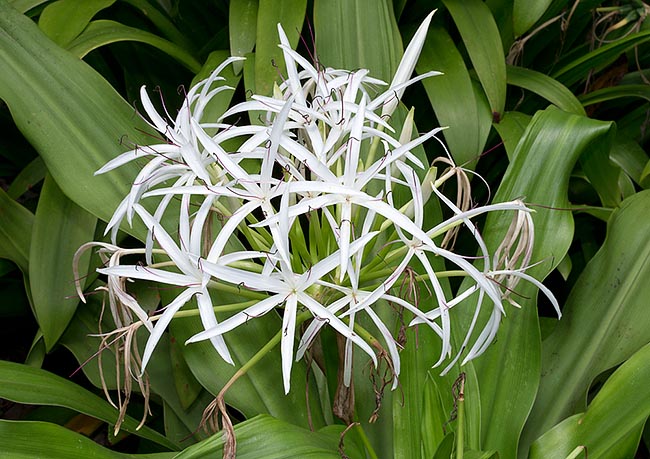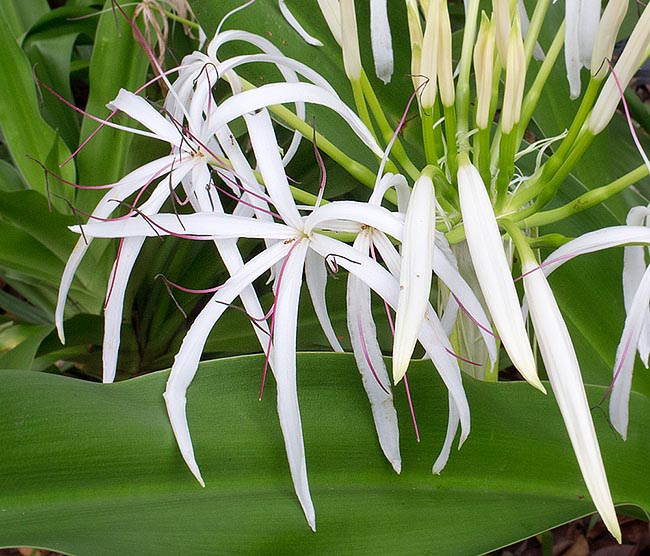Family : Amaryllidaceae

Text © Pietro Puccio

English translation by Mario Beltramini

Crinum asiaticum is a rather variable bulbous everegreen of South-East Asia reaching 1,2-2 m of height, with bulbs up to 15 cm of diameter and up to 50 cm tall pseudo-stem. Umbel-like 0,5-1,2 m inflorescences © Giuseppe Mazza
The species is native to Andaman Islands, Assam, Australia (New South Wales, Northern Territory and Queensland), Bangladesh, Bismarck Islands, Borneo, Cambodia, China (Anhui, Fujian, Guangdong, Guangxi, Henan, Hong Kong, Hunan, Jiangsu, Jiangxi, Kin-Men, Macau, Ma-tsu-Pai-chúan, Shanghai and Zhejiang), Christmas Islands, Cocos Islands, Fiji, India, Japan, Java, Korea, Laos, Lesser Sunda Islands, Malaysia, Maldives, Mauritius, Moluccas, Nansei-shoto, New Caledonia, New Guinea, Nicobar Islands, Norfolk Islands, Ogasawara-shoto, Paracel Islands, Philippines, Réunion, Rodrigues, Salomon Islands, Samoa, Seychelles, Sri Lanka, Sulawesi, Sumatra, Taiwan, Thailand, Vanuatu and Vietnam where it grows in the humid forests, often along the banks of water streams, or along the coasts on the sand or among the mangroves.
The name of the genus comes from the Greek “κρινον” (krinon) = lily; the specific name is the Latin adjective “asiaticus, a, um” = Asian, with obvious reference.
Common names: Asiatic poison bulb, crinum lily, grand crinum, poison bulb, seashore lily, tree crinum, tree lily (English); luo qun dai (Chinese); hama-omoto (Japanese); barakanur, cindar, nagadamani, nagdowan, pindar, sudarshan, vishamandala (Hindi); bakong, fete-fete, kajang-kajang (Indonesian); bakong, bawang tanah (Malaysian); agabahan, biliba (Tagalog); lilua (Tha); la nang, nang hoa trang (Vietnamese).
The Crinum asiaticum L. (1753) is a rather variable bulbous evergreen, 1,2-2 m tall, with bulbs up to 15 cm of diameter and pseudo-stem, up to 50 cm tall, covered by the old foliar sheaths. The leaves are linear-lanceolate with entire margin and pointed apex, fleshy, 0,5-1,8 m long and 7-14 cm broad, of glossy pale green colour. Umbel inflorescence, on a 0,5-1,2 m long erect scape, enclosed at the base by two membranous lanceolate bracts, bearing 15-50 white flowers delicately scented, in particular in the night hours, opening in succession. Imbutiform perianth with pale green, 4-7 cm long, cylindrical tube, linear lobes with more or less pointed apex, curved, 6-10 cm long and 0,6-1,2 cm broad, white filaments at the base, purple in the second half, 5-8 cm long, yellow anthers, 1,2-2 cm long and style white at the base, then purple, 8-12 cm long. The fruits are sub-globose polymorphous capsules, 3-5,5 cm broad, with fleshy and thin yellowish green pericarp, containing 1-3 sub-globose seeds, 3-4 cm long.

It has 15-50 white flowers gently scented with showy linear 6-10 cm lobes. All parts of the plant are poisonous but the bulb and the leaves are used since time in the traditional medicine for various pathologies © Giuseppe Mazza
It easily reproduces by seed, placed superficially in loam rich of humus maintained humid at the temperature of 24-26 °C, with the first blooming by the third, fourth year of age, by division and through the small bulbs it produces at the base.
Species of great ornamental and landscape value diffused, besides in the origin paces, in all the countries with tropical and subtropical climate, often naturalizing, cultivable also in the temperate-warm ones where can stand, with damage to the foliage, temperatures up to -4 °C, provided exceptional and for very short period. It requires full sun or slight shade and is not particular about the soil, but grows best in the deep, draining, rich of organic substance ones, maintained preferably humid, even if it can bear dry periods; furthermore, has a good resistance to the saltiness, can be therefore utilized in coastal gardens.
In the least favourable climates can be cultivated in capacious containers, to be sheltered during the coldest months in particularly luminous ambient, with organic loam with addition of sand per a 30% to improve the drainage. The waterings must be regular, but allowing to dry up before giving water again to avoid stagnations that might favour, in presence of low temperatures, rottenness, with periodical fertilizations, in spring-summer, utilizing a balanced products with microelements.
All parts of the plant are poisonous if ingested and the sap may cause skin irritations to the most sensitive subjects; the bulb and the leaves are since remote times variously utilized in the traditional medicine, in particular the Chinese and Indian ones, for various pathologies.
Synonyms: Bulbine asiatica (L.) Gaertn. (1788); Crinum albiflorum Noronha (1790); Lilium pendulum Noronha (1790); Crinum bracteatum Willd. (1799); Crinum floridum Fraser ex Herb. (1820); Crinum carinifolium Stokes (1812); Crinum toxicarium Roxb. (1814); Crinum sumatranum Roxb. (1817); Crinum umbellatum Carey ex Herb. (1820); Crinum anomalum Herb. (1821); Crinum declinatum Herb. (1821); Crinum procerum Herb. & Carey (1821); Crinum brevifolium Roxb. (1824); Crinum plicatum Livingstone ex Hook. (1829); Crinum asiaticum var. declinatum Herb. (1837); Crinum rigidum Herb. (1837); Haemanthus pubescens Blanco (1837); Crinum angustifolium Herb. ex Steud. (1840); Crinum hornemannianum M.Roem. (1847); Crinum redouteanum M.Roem. (1847); Crinum macrocarpum Carey ex Kunth (1850); Crinum bancanum Kurz (1864); Crinum northianum Baker (1882); Crinum macrantherum Engl. (1886); Crinum asiaticum var. procerum (Herb. & Carey) Baker (1888); Amaryllis carnosa Hook.f. (1892); Crinum cortifolium Hallier f. (1913); Crinum macrophyllum Hallier f. (1913); Crinum rumphii Merr. (1917); Crinum zanthophyllum Hannibal (1972); Crinum woolliamsii L.S.Hannibal (1987).
→ To appreciate the biodiversity within the AMARYLLIDACEAE family please click here.
